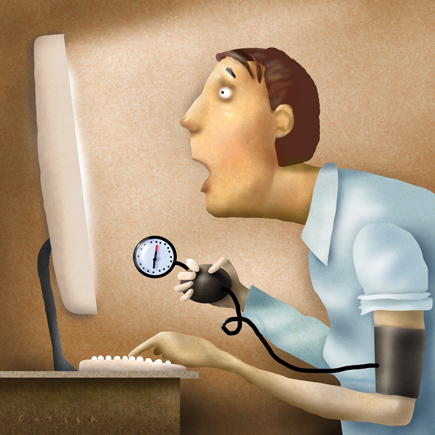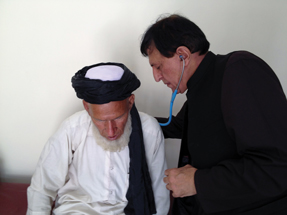Patients increasingly checking ‘Dr. Google’
More than a third of patients have gone online to identify a medical condition, raising concerns about “cyberchondria” and requiring physicians to adapt to help patients differentiate the helpful websites from the misleading ones.
As a family physician who has used an electronic medical record for 12 years, Gary Bevill, MD, sees himself as open to new technological advances. But the advent of Internet tools that allowed patients to enter their symptoms and receive possible diagnoses displeased him and many physicians.
“I like to think I'm semi-wired,” Dr. Bevill said. “But as a general rule, the early symptom checkers, I basically hated with a passion.”

The increasing tendency of patients to visit “Dr. Google”—35% of U.S. adults have gone online to try to identify a medical condition in themselves or someone else, according to a 2013 survey from Pew Research Center—raised several concerns.
“The classic physician concern is the patient will put in headache, and they're going to get freaked out because brain tumor will come up, and we're going to be inundated with people coming in with [imagined] brain tumors,” said Jason Maude, founder and CEO of Isabel Healthcare, a company that offers an online symptom checker for patients.
This phenomenon even spawned a new term, “cyberchondria.” But advocates of these Web tools argue that physicians who hate symptom checkers might be suffering from excessive worry themselves.
“Any time a patient can be more informed about their health and what their symptoms might mean, I think that's a good thing,” said Charles Bareis, MD, FACP, chief medical officer of Vanguard MacNeal Hospital in Chicago.
Regardless of their feelings about them, he added, physicians need to adapt their practices to deal effectively with symptom checkers. “It's almost irrelevant what I as a physician think about it, because patients are doing it anyway,” Dr. Bareis said.
Dr. Bevill, whose practice, SAMA HealthCare Services in El Dorado, Ark., recently added a symptom checker to its website, agreed. “Why not embrace it?” he said. “Just look at all this as a tool.”
Take one for a spin
As with any tool, an effective understanding of symptom checkers requires some practice. Physicians should try out the online tools that their patients may be using, experts advised.
“You've got to put on your consumer hat when you do it, and say, ‘For a person without a medical degree, would this be helpful or not helpful?’” said Philip Hagen, MD, a senior medical editor for MayoClinic.com, which offers a symptom checker.
However, physicians should also use some medical expertise in their evaluations. “You can help ensure the accuracy of the information by looking for sites that have board-certified, practicing physicians reviewing the content regularly and making sure the sources used for the content and tools are solid,” said ACP Member Michael Smith, MD, chief medical editor of WebMD, which also has a symptom checker.
Symptom checkers are offered by some health care institutions, including the Mayo and Cleveland Clinics, as well as online-only businesses, like WebMD. Isabel is a recent entrant to the market, having expanded its diagnostic tool for physicians to layperson use this year. The tools vary in design, asking patients to click on a body part or choose symptoms, with different degrees of follow-up questioning, before diagnostic suggestions are provided.
Experts caution that those results are only suggestions. “They're not intended for people to self-diagnose,” said Dr. Hagen. “They are intended to help people sort through whether or not this is something that needs immediate attention, and if the answer's no, what you can do in the meantime.”
“Online health information and symptom checkers are not intended to replace the doctor's visit,” agreed Dr. Smith.
Or at least not necessary doctor's visits. The tools could help patients decide when an appointment is needed, some experts said. “It's what 30 years ago the doctor's nurse might have done. The patient might have called and said, ‘I'm not sure if I need to come in and see the doctor. What do you think?’” said Dr. Hagen. If this kind of use prevented unneeded visits, symptom checkers could be a time- and cost-saver, he added.
On the other end, symptom checkers could encourage a patient to seek care when it is urgently needed. “That allows them hopefully to recognize more serious symptoms quicker and not ignore them,” said Dr. Bareis.
Changing the visit
There's also potential benefit when the patient's problem is somewhere between urgent and treatable at home, experts said. “When they get to the doctor's office, they've already started an organized thought process, and I think it makes the interaction with the doctor much more fruitful, efficient. It allows the doctor to get to a higher level of interaction, diagnosis, treatment quicker,” Dr. Hagen said.
“The better informed patient is much easier to deal with,” agreed Mr. Maude.
Unless, of course, the patient has misinformed himself through previsit symptom checking. As leery physicians predicted, this is one of the major downsides of symptom checking. “If it's a migraine, for example, instead of being able to talk to them about prevention and treatment, I spend a lot of the visit explaining why it's not multiple sclerosis,” said Dr. Bevill.
Patients had such worries even before symptom checkers, though, countered Dr. Hagen. “Our patients come in using whatever background they have. That may be what their neighbor told them or what they learned in grade school. I don't think that the diagnostic tools worsen that fear factor,” he said.
The symptom checker developers do try to prevent users from coming to inaccurate, severe diagnoses for themselves. “We have a team of physicians monitoring the tool and feedback from consumers and health professionals,” said Dr. Smith. “We even use incidence and prevalence rates to help inform possible conditions that are present and where they appear on the list of possibilities.”
The websites almost always provide a list of possible diagnoses, which they expect patients to narrow in concert with their physicians. “It should be the patient and physician together working jointly to produce a differential diagnosis,” said Mr. Maude.
Talk about tools
To accomplish that cooperative process, physicians have to be receptive to patients' discussion of their Internet findings.
“If they come to the office with a stack of papers, you need to sit down with them and look through it,” said ACP Member Kevin Pho, MD, an internist in Nashua, N.H., and founder of the blog KevinMD.com. “Don't tell them not to [use symptom checkers], because they're going to do it anyway,” he added.
Expressing disapproval of the tools may just create a barrier to open patient-physician communication in the future, the experts said. “If physicians avoid the topic, patients will not feel comfortable discussing what they find and may use [symptom checkers] inappropriately,” said Dr. Smith.
To verify that patients are using symptom checkers appropriately, ask them some questions, suggested Dr. Hagen, such as “What program did you use? And how did you decide whether it was valid?”
Encourage patients, in return, to ask you questions about the information they've found. “The doctor is really the filter that can provide context for the patient. It can be overwhelming how the symptom checkers list thousands of diagnoses,” said Dr. Pho.
Make sure, also, that patients clearly understand the limitations of these Web tools. “Have the conversation with your patients and help them understand how best to use the information. It's information, not medical advice,” said Dr. Smith. “We explain to them that you should use the information to help round out the care and information your doctor gives, not to replace it.”
For patients who come to a visit with information from a symptom checker, this conversation is a necessity, but experts debated whether a physician should also delve into the subject with patients who give no sign of using symptom checkers.
Some favored proactively raising the subject and endorsing any symptom checker that you've explored and found useful. “If you see a site that you like, recommend it,” said Dr. Smith.
Others prefer to let patients take the lead. Although Dr. Bevill's practice now offers Isabel's symptom checker on its website, he lets patients find it on their own. “I don't really encourage it,” he said.
With or without physicians' encouragement, however, symptom checkers are likely here to stay. The format may change (see sidebar), but in some manner, patients will continue to access the growing store of medical knowledge on the Internet.
“For me, this is about the democratization of health care. All that knowledge should not reside in just the physician's head,” said Mr. Maude.
This leveling of the information imbalance may be uncomfortable for physicians for a while, but eventually it should result in better care, experts said.
“Physicians have a new role as information curators rather than being the sole source of information. The sooner we accept that new role, the better we'll adjust to how the doctor-patient relationship is evolving,” said Dr. Pho.
And don't worry, the experts added, the doctor's role may be changing, but it's expected to remain important for a long time to come.
“All of us have had that lurking fear that we'll be replaced by a computer someday. I don't think [symptom checkers] will do that,” said Dr. Hagen. “It will change the way that we practice medicine, but I don't think it will prevent the need of a physician.”





